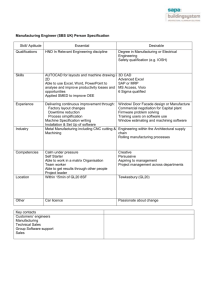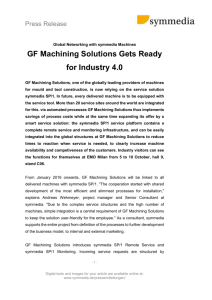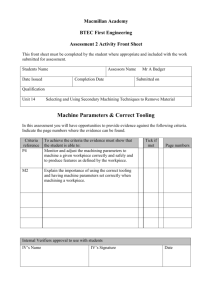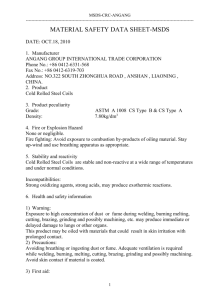Ch. 26 – Abrasive Machining and Finishing Operations
advertisement
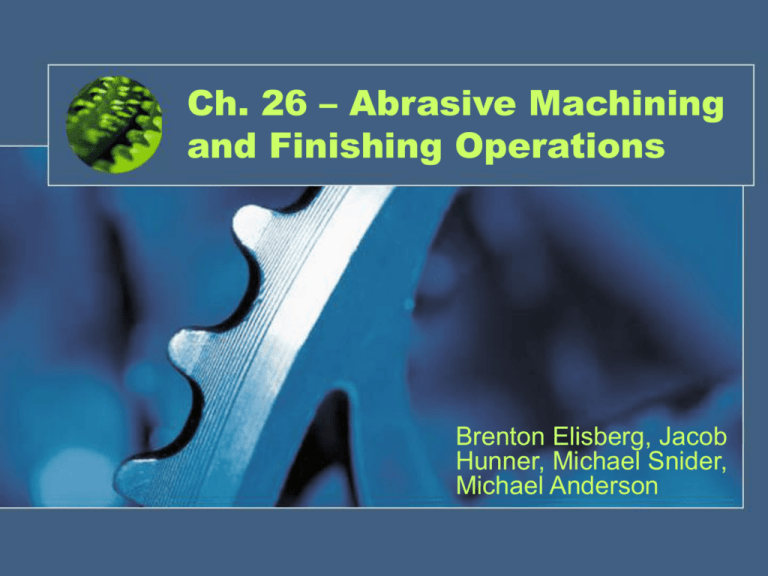
Ch. 26 – Abrasive Machining and Finishing Operations Brenton Elisberg, Jacob Hunner, Michael Snider, Michael Anderson Abrasive Machining and Finishing Operations • There are many situations where the processes of manufacturing we’ve learned about cannot produce the required dimensional accuracy and/or surface finish. – Fine finishes on ball/roller bearings, pistons, valves, gears, cams, etc. – The best methods for producing such accuracy and finishes involve abrasive machining. Abrasives and Bonded Abrasives • An abrasive is a small, hard particle having sharp edges and an irregular shape. • Abrasives are capable of removing small amounts of material through a cutting process that produces tiny chips. Abrasives and Bonded Abrasives • Commonly used abrasives in abrasive machining are: – Conventional Abrasives • Aluminum Oxide • Silicon Carbide – Superabrasives • Cubic boron nitride • Diamond Friability • Characteristic of abrasives. • Defined as the ability of abrasive grains to fracture into smaller pieces, essential to maintaining sharpness of abrasive during use. • High friable abrasive grains fragment more under grinding forces, low friable abrasive grains fragment less. Abrasive Types • Abrasives commonly found in nature include: – – – – – Emery Corundum Quartz Garnet Diamond Abrasive Types • Synthetically created abrasives include: – – – – Aluminum oxide (1893) Seeded gel (1987) Silicon carbide (1891) Cubic-boron nitride (1970’s) – Synthetic diamond (1955) Abrasive Grain Size • Abrasives are usually much smaller than the cutting tools in manufacturing processes. • Size of abrasive grain measured by grit number. – Smaller grain size, the larger the grit number. – Ex: with sandpaper 10 is very coarse, 100 is fine, and 500 is very fine grain. Grinding Wheels • Large amounts can be removed when many grains act together. This is done by using bonded abrasives. – This is typically in the form of a grinding wheel. – The abrasive grains in a grinding wheel are held together by a bonding material. Bonding Abrasives • Bonding materials act as supporting posts or braces between grains. • Bonding abrasives are marked with letters and numbers indicating: – – – – – Type of abrasive Grain size Grade Structure Bond type Bond Types • Vitrified: a glass bond, most commonly used bonding material. – However, it is a brittle bond. • Resinoid: bond consiting of thermosetting resins, bond is an organic compound. – More flexible bond than vitrified, also more resistant to higher temps. Bond Types • Reinforced Wheels: bond consisting of one or more layers of fiberglass. – Prevents breakage rather than improving strength. • Rubber: flexible bond type, inexpensive. • Metal: different metals can be used for strength, ductility, etc. – Most inexpensive bond type. The Grinding Process • Grinding is a chip removal process that uses an individual abrasive grain as the cutting tool. • The differences between grinding and a single point cutting tool is: – The abrasive grains have irregular shapes and are spaced randomly along the periphery of the wheel. – The average rake angle of the grain is typically -60 degrees. Consequently, grinding chips undergo much larger plastic deformation than they do in other machining processes. – Not all grains are active on the wheel. – Surface speeds involving grinding are very fast. (a) (b) Grinding Forces • A knowledge of grinding forces is essential for: – Estimating power requirements. – Designing grinding machines and workholding fixtures and devices. – Determining the deflections that the workpiece as well as the grinding machine may undergo. Deflections adversely affect dimensioning. Grinding Forces • Forces in grinding are usually smaller than those in machining operations because of the smaller dimensions involved. • Low grinding forces are recommended for dimensional accuracy. Problems with Grinding • Wear Flat – After some use, grains along the periphery of the wheel develop a wear flat. • Wear flats rub along the ground surface, creating friction, and making grinding very inefficient. Problems with Grinding • Sparks – Sparks produced from grinding are actually glowing hot chips. • Tempering – Excessive heat, often times from friction, can soften the work-piece. • Burning – Excessive heat may burn the surface being ground. Characterized as a bluish color on ground steel surfaces. Problems with Grinding • Heat Checking – High temps in grinding may cause cracks in the work-piece, usually perpendicular to the grinding surface. Grain Fracture • Abrasive grains are brittle, and their fracture characteristics are important. • Wear flat creates unwanted high temps. • Ideally, the grain should fracture at a moderate rate so as to create new sharp cutting edges continuously. Bond Fracture • The strength of the abrasive bond is very important! • If the bond is too strong, dull grains cannot dislodge to make way for new sharp grains. – Hard grade bonds are meant for soft materials. • If too weak, grains dislodge too easily and the wear of the wheel increases greatly. – Soft grade bonds are meant for hard materials. Grinding Ratio • G = (Volume of material removed)/ Volume of wheel wear) • The higher the ratio, the longer the wheel will last. • During grinding, the wheel may act “soft” or hard” regardless of wheel grade. – Ex: pencil acting hard on soft paper and soft on rough paper. Dressing, Truing, Shaping • “Dressing” a wheel is the process of: – Conditioning worn grains by producing sharp new edges. – Truing, which is producing a true circle on the wheel that has become out of round. • Grinding wheels can also be shaped to the form of the piece you are grinding. • These are important because they affect the grinding forces and surface finish. Grinding Operations and Machines • • • • • • • Surface Grinding Cylindrical Grinding Internal Grinding Centerless Grinding Creep-feed Grinding Heavy Stock Removal by Grinding Grinding fluids Grinding Operations and Machines • Surface Grinding grinding of flat surfaces • Cylindrical Grinding – axially ground Grinding Operations and Machines • Internal Grinding grinding the inside diameter of a part • Creep-feed Grinding – large rates of grinding for a close to finished piece Grinding Operations and Machines • Centerless Grinding – continuously ground cylindrical surfaces Grinding Operations and Machines • Heavy Stock Removal economical process to remove large amount of material • Grinding Fluids – Prevent workpiece temperature rise – Improves surface finish and dimensional accuracy – Reduces wheel wear, loading, and power consumption Design Consideration for Grinding • Part design should include secure mounting into workholding devices. • Holes and keyways may cause vibration and chatter, reducing dimensional accuracy. • Cylindrically ground pieces should be balanced. Fillets and radii made as large as possible, or relieved by prior machining. Design Considerations for Grinding • Long pieces are given better support in centerless grinding, and only the largest diameter may be ground in through-feed grinding. • Avoid frequent wheel dressing by keeping the piece simple. • A relief should be include in small and blind holes needing internal grinding. Finishing Operations • • • • • • • • Coated abrasives Belt Grinding Wire Brushing Honing Superfinishing Lapping Chemical-Mechanical Polishing Electroplating Finishing Operations • Coated Abrasives – have a more pointed and open structure than grinding wheels • Belt Grinding – high rate of material removal with good surface finish Finishing Operations • Wire Brushing produces a fine or controlled texture • Honing – improves surface after boring, drilling, or internal grinding Finishing Operations • Superfinishing – very light pressure in a different path to the piece • Lapping – abrasive or slurry wears the piece’s ridges down softly Finishing Operations • Chemicalmechanical Polishing – slurry of abrasive particles and a controlled chemical corrosive • Electropolishing – an unidirectional pattern by removing metal from the surface Deburring Operations • • • • • • • Manual Deburring Mechanical Deburring Vibratory and Barrel Finishing Shot Blasting Abrasive-Flow Machining Thermal Energy Deburring Robotic Deburring Deburring Operations • Vibratory and Barrel Finishing – abrasive pellets are tumbled or vibrated to deburr • Abrasive-flow Machining – a putty of abrasive grains is forced through a piece Deburring Operations • Thermal Energy Deburring – natural gas and oxygen are ignited to melt the burr • Robotic Deburring – uses a force-feedback program to control the rate and path of deburring Economics of Abrasive Machining and Finishing Operations • Creep-feed grinding is an economical alternative to other machining operations. • The use of abrasives and finishing operations achieve a higher dimensional accuracy than the solitary machining process. • Automation has reduced labor cost and production times. • The greater the surface-finish, the more operations involved, increases the product cost. • Abrasive processes and finishing processes are important to include in the design analysis for pieces requiring a surface finish and dimensional Chapter 27 – Advanced Machining Processes Chapter 27 – Advanced Mechanical Processes • Advanced Machining Processes can be used when mechanical methods are not satisfactory, economical or possible due to: – – – – High strength or hardness Too brittle or too flexible Complex shapes Special finish and dimensional tolerance requirements – Temperature rise and residual stresses Advanced Mechanical Processes • These advanced methods began to be introduced in the 1940's. • Removes material by chemical dissolution, etching, melting, evaporation, and hydrodynamic action. • These requirements led to chemical, electrical, laser, and high-energy beams as energy sources for removing material from metallic or non-metallic workpieces. Chemical Machining • Chemical machining – Uses chemical dissolution to dissolve material from the workpiece. – Can be used on stones, most metals and some ceramics. – Oldest of the advanced machining processes. Chemical Machining • Chemical milling - shallow cavities are produced on plates, sheets, forgings, and extrusions, generally for the overall reduction of weight. – Can be used with depths of metal removal as large as 12 mm. – Masking is used to protect areas that are not meant to be attacked by the chemical. Chemical Machining • Chemical Blanking – similar to the blanking of sheet metals with the exception that the material is removed by chemical dissolution rather than by shearing. – Printed circuit boards. – Decorative panels. – Thin sheet-metal stampings. – Complex or small shapes. Chemical Machining • Surface Roughness and Tolerance table Chemical Machining • Photochemical blanking/machining – Modification of chemical milling. – Can be used on metals as thin as .0025 mm. • Applications – – – – – Fine screens. Printed circuit boards. Electric-motor laminations. Flat springs. Masks for color televisions. Chemical Machining • Chemical machining design considerations – No sharp corners, deep or narrow cavities, severe tapers, folded seam, or porous workpiece materials. – Undercuts may develop. – The bulk of the workpiece should be shaped by other processes prior to chemical machining. Electrochemical Machining • Electrochemical machining (ECM) – An electrolyte acts as a current carrier which washes metal ions away from the workpiece (anode) before they have a chance to plate on the tool (cathode). – The shaped tool is either solid or tubular. – Generally made of brass, copper, bronze or stainless steel. – The electrolyte is a highly conductive inorganic fluid. Electrochemical Machining • Electrochemical machining cont. – The cavity produced is the female mating image of the tool shape. • Process capabilities – Generally used to machine complex cavities and shapes in high strength materials. • Design considerations – Not suited for producing sharp square corners or flat bottoms. – No irregular cavities. Electrochemical Machining Electrochemical Machining • Pulsed electrochemical machining (PECM) – – – – – Refinement of ECM. The current is pulsed instead of a direct current. Lower electrolyte flow rate. Improves fatigue life. Tolerance obtained 20 to 100 micro-meters. (a) (b) Electrochemical Grinding • Electrochemical grinding (ECG) – Combines ECM with conventional grinding. – Similar to a conventional grinder, except that the wheel is a rotating cathode with abrasive particles. • The abrasive particles serve as insulators and they remove electrolytic products from the working area. – Less then 5% of the metal is removed by the abrasive action of the wheel. Electrochemical Grinding • Electrochemical honing – Combines the fine abrasive action of honing with electrochemical action. – Costs more than conventional honing. – 5 times faster than conventional honing. – The tool lasts up to 10 times longer. • Design considerations for EGC – Avoid sharp inside radii. Electrical Discharge Machining (EDM) • Principle of operation – Based on the erosion of metal by spark discharge • Components of operation – Shaped tool • Electrode – Workpiece • Connected to a DC power supply – Dielectric • Nonconductive fluid Electrical Discharge Machining (EDM) • When the potential difference is sufficiently high, the dielectric breaks down and a transient spark discharges through the fluid, removing a very small amount of material from the workpiece • Capacitor discharge – 200-500 kHz • This process can be used on any electrically conductive material Electrical Discharge Machining (EDM) • Volume of material removed per discharge – 10^-10 to 10^-8 in^3 • Material removal can be predicted – – – – MRR = 4*10^4 I*Tw^-1.23 MRR is mm^3/min I is current in amperes Tw is melting point (C) • Mechanical energy is not a factor • The hardness, strength, and toughness do not necessarily influence the removal rate Electrical Discharge Machining (EDM) • Movement in the X&Y axis is controlled by CNC systems • Overcut (in the Z axis) is the gap between the electrode and the workpiece – Controlled by servomechanisms – Critical to maintain a constant gap Electrical Discharge Machining (EDM) • Dielectric fluids – Act as a dielectric – Provide a cooling medium – Provide a flushing medium • Common fluids – – – – Mineral oils Distilled/Deionized water Kerosene Other clear low viscosity fluids are available which are easier to clean but more expensive Electrical Discharge Machining (EDM) • Electrodes – – – – Graphite Brass Copper-tungsten alloys Formed by casting, powder metallurgy, or CNC machining – On right, human hair with a 0.0012 inch hole drilled through Electrical Discharge Machining (EDM) • Electrode wear – Important factor in maintaining the gap between the electrode and the workpiece – Wear ratio is defined as the amount of material removed to the volume of electrode wear • 3:1 to 100:1 is typical – No-wear EDM is defined as the EDM process with reversed polarity using copper electrodes Electrical Discharge Machining (EDM) • Process capabilities – Used in the forming of dies for forging, extrusion, die casting, and injection molding – Typically intricate shapes Electrical Discharge Machining (EDM) • Material removal rates affect finish quality – High removal rates produce very rough surface finish with poor surface integrity – Finishing cuts are often made at low removal rates so surface finish can be improved • Design considerations – Design so that electrodes can be simple/economical to produce – Deep slots and narrow openings should be avoided – Conventional techniques should be used to remove the bulk of material Wire EDM • Similar to contour cutting with a bandsaw • Typically used to cut thicker material – Up to 12” thick – Also used to make punches, tools and dies from hard materials Wire EDM • Wire – – – – – Usually made of brass, copper, or tungsten Range in diameter from 0.012 – 0.008 inches Typically used at 60% of tensile strength Used once since it is relatively inexpensive Travels at a constant velocity ranging from 6-360 in/min – Cutting speed is measured in cross sectional area per unit time (varies with material) • 18,000 mm^2/hour • 28 in^2/hour Wire EDM • Multiaxis EDM – Computer controls for controlling the cutting path of the wire and its angle with respect to the workpiece plane – Multiheads for cutting multiple parts – Features to prevent and correct wire breakage – Programming to optimize the operation Electrical Discharge Grinding • Similar to the standard grinder • Grinding wheel is made of graphite or brass and contains no abrasives • Material is removed by spark discharge between the workpiece and rotating wheel • Typically used to sharpen carbide tools and dies • Can also be used on fragile parts such as surgical needles, thin-wall tubes, and honeycomb structures • Process can be combined with electrochemical discharge grinding • Material removal rate is similar to that of EDM – MRR = KI where K is the workpiece material factor in mm^3/Amin Laser Beam Machining • The source of the energy is the laser – Light Amplification by Stimulated Emission of Radiation • The focus of optical energy on the surface of the workpiece melts and evaporates portions of the workpiece in a controlled manner – Works on both metallic and non-metallic materials • Important considerations include the reflectivity and thermal conductivity of the material • The lower these quantities the more efficient the process Laser Beam Machining • The cutting depth can be calculated using the formula t = CP/vd where – – – – – t is the depth C is a constant for the process P is the power input v is the cutting speed d is the laser spot diameter • The surface produced is usually rough and has a heat affected zone (discussed in section 30.9) Laser Beam Machining • Lasers may be used in conjunction with a gas such as oxygen, nitrogen, or argon to aid in energy absorption – Commonly referred to as laser beam torches – The gas helps blow away molten and vaporized material • Process capabilities also include welding, localized heat treating, and marking • Very flexible process – Fiber optic beam delivery – Simple fixtures – Low setup times Laser Beam Machining • Design considerations – Sharp corners should be avoided – Deep cuts will produce tapered walls – Reflectivity is an important consideration • Dull and unpolished surfaces are preferable – Any adverse effects on the properties of the machined materials caused by the high local temperatures and heat affected zones should be investigated Electron Beam Machining • Energy source is high velocity electrons which strike the workpiece • Voltages range from 50-200kV • Electron speeds range from 50-80% the speed of light • Require a vacuum Electron Beam Machining • Plasma arc cutting – Ionized gas is used to rapidly cut ferrous and nonferrous sheets and plates – Temperatures range from 9400-17,000 F – The process is fast, the kerf width is small, and the surface finish is good – Parts as thick as 6” can be cut – Much faster than the EDM and LBM process – Design considerations • Parts must fit in vacuum chamber • Parts that only require EBM machining on a small portion should be manufactured as a number of smaller components Water Jet Machining • Also known as hydrodynamic machining • The water jet acts as a saw and cuts a narrow groove in the material • Pressures range from 60ksi to 200ksi Water Jet Machining • Process capabilities – Can be used on any material up to 1” thick – Cuts can be started at any location without predrilled holes – No heat produced – No flex to the material being cut • Suitable for flexible materials – Little wetting of the workpiece – Little to no burr produced – Environmentally safe Water Jet Machining • Very similar to water jet machining – Water contains abrasive material • Silicon carbide • Aluminum oxide – Higher cutting speed than that of conventional water jet machining • Up to 25 ft/min for reinforce plastics – Minimum hole diameter thus far is approximately 0.12 inches – Maximum hole depth is approximately 1 inch Abrasive Jet Machining • Uses high velocity dry air, nitrogen, or carbon dioxide containing abrasive particles • Supply pressure is on the order of 125psi • The abrasive jet velocity can be as high as 100 ft/sec • Abrasive size is approximately 400-2000 micro-inches Economics of Advanced Machining Processes • Advanced machining processes each have unique applications • The economic production run for a particular process depends on the costs of tooling, equipment, operating costs, material removal rate required, level of operator skill required, and necessary secondary and finishing operations • Chemical machining has the added cost of reagents, maskants, and disposal • Table 27.1 lists material removal rates for all advanced machining processes References http://www.electricaldischargemachining.com/ http://www.belmont4edm.com/ http://www.texasairsonics.com/Cabinet%20Style.html


